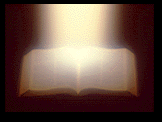



THE KING JAMES BIBLE
January 24, 2009
Click Here for a Printable Version of this Page
Copyright © 1987-1998 RLP. All
Rights Reserved. You are encouraged to freely distribute this writing in its
complete form so long as there is no charge (except reasonable duplication fees)
and this cover page must accompany the document at all times. Quotations of this
text are permitted and encouraged.
THE KING JAMES BIBLE
The King James Version is the most
popular translation of the
Bible in existence. We shall discuss the history of this book and
examine its construction and sequencing.
When Queen Elizabeth of England
died in 1603, King James VI of
Scotland took the throne as King James I. There were at least
three popular versions of the Bible at that time: The Geneva
Bible, the Great Bible and the Bishop's Bible. In January, 1604
the Puritans asked King James I for a new translation. Work on
the new Bible began in 1607 with 47 translators who met twice each
day. The translators worked in 6 groups at 3 major universities.
2 groups worked at Oxford, 2 groups worked at Cambridge and the
last 2 groups did their work at Westminster. In 1611, the first
version was ready for publication. As with any other publication,
revisions were made. The Apocrypha, writings apparently of
Christian nature, were at first included in the King James
Version. Because of their dubious authenticity, they were
eventually eliminated in subsequent revisions. Today's version is
quite close to a revision published in 1769. However, there is
now available a Revised King James Version which is even more
contemporary.
The King James writers recognized
the translation problems
they would encounter. In the King James Bible, the italicized
words are actually "extra" words inserted to make the meaning
clearer; these words are not actually found in the Hebrew or Greek
language. Let's look at the appendix in a King James Bible:
Readers of the King James Version
now and again
come upon words printed in italics; that is to say,
with slanting letters. Some have supposed, mistakenly,
that these words were printed in this fashion for
emphasis. This is not the case. The words in italics
are words which do not have any equivalents in the
Hebrew or Greek text. They are words which have been
supplied by the translators in order to make the
meaning of the sentence clearer, or in order to make
the passage read more smoothly in English. Numerous
italicized words are found in the fifth chapter of
Matthew, and they occur with almost equal frequency in
other parts of the Scriptures.
The Geneva Bible, which was a
pioneer version in
many different ways, was the first to use italics in
this fashion (4, italicized words mine).
The Bible is actually a collection
of 66 books written by at
least 40 human authors. Christianity, which is based on the
Bible, is the only religion that claims a resurrected Savior,
Christ. The Bible is a work of long compilation since the
writings of its books span at least 1500 years. It is an ancient
writing in that the last author of any of the books, the Apostle
John, died approximately 1900 years ago. The two major divisions
are the Old Testament and the New Testament.
The Old Testament is comprised of 39 books, Genesis to Malachi
The books of the Old Testament
were written over a period of
about 1000 years. The Old Testament can be divided into 4 major
subdivisions:
(A) History:
Genesis thru Esther (17 books)
(B) Poetry/Wisdom Literature: Job thru Song of Solomon (5
books)
(C) Major Prophets: Isaiah thru Daniel (5 books)
(D) Minor Prophets: Hosea thru Malachi (12 books)
Genesis to Esther are 17 books which deal with History.
The first 5 books are known as the
Pentateuch and are Genesis,
Exodus, Leviticus, Numbers and Deuteronomy. These books are also
known as the Mosaic Law because it is generally accepted that
Moses was the author of all 5 books or at least the majority of
each. The books also cover the pre-Canaan or Promised Land
existence of the Israelites.
The next 12 books are Joshua to
Esther and can be divided into
to 2 subcategories. The first 9 of these 12 books are Joshua,
Judges, Ruth, I Samuel, II Samuel, I Kings, II Kings, I Chronicles
and II Chronicles. These books record the experiences in Canaan.
The last 3 of these 12 books are
Ezra, Nehemiah and Esther.
These books are the post-exile from Canaan history.
The 5 books in the center of
the Old Testament are Poetry and
Wisdom Literature.
These books are Job, Psalms,
Proverbs, Ecclesiastes and Song
of Solomon. These books contain, respectively, writings of the 5
following subjects: (1) human tragedy and suffering; (2) poetry of
praise, prophesy, problems and peace; (3) wisdom for life; (4) the
meaninglessness of life apart from God and the futility of
autonomous human wisdom; (5) God's gift of the relation of love
between men and women, which is actually a foreshadowing of the
relationship between Christ and the Church.
The last 17 books of the Old Testament are the Prophets.
These are divided into 2 main
categories: the Major Prophets
and the Minor Prophets.
The Major Prophets are made up of
5 books and are Isaiah,
Jeremiah, Lamentations, Ezekiel and Daniel.
The Minor Prophets are made up of
the last 12 books of the Old
Testament and are Hosea, Joel, Amos, Obadiah, Jonah, Micah, Nahum,
Habakkuk, Zephaniah, Haggai, Zechariah and Malachi.
The New Testament is comprised of 27 books, Matthew to Revelation.
The books of the New Testament
were written over a period of
approximately 100 years. The approximate 1500 year span of the
writings of the Bible is completed in the roughly 400 years
between the last writing of the Old Testament and the first
writing of the New Testament. There are four major subdivisions
of the New Testament:
(A) History: 4
Gospels and the Book of Acts (5 books)
(B) Paul's Epistles: Romans thru Philemon (13 books)
(C) General Epistles: Hebrews thru Jude (8 books)
(D) Apocalypse: Revelation (1 book)
The first 5 books are
Historical books which include the
Gospels of Jesus Christ and the Book of Acts.
The Gospels are Matthew, Mark,
Luke and John. Of these,
Matthew, Mark and Luke are known as the synoptic Gospels, which
means they contain much mutual agreement on the life of Christ.
Matthew was a Jewish tax collector and his Gospel is written from
a Jewish perspective. Mark had served as a missionary with the
Apostle Paul and his Gospel was written from a Roman perspective.
Church tradition attributes Mark's Gospel to his recording of the
Apostle Peter's preaching and teaching. Luke was a physician and
his Gospel was written from a Greek perspective. John, who had a
fishing business, made it clear that Jesus was God in human form
and is recommended reading for new Christians.
The next book is the Book of Acts
and it was written by Luke.
Acts deals with the formation and spread of the church, but most
importantly, the coming of the Holy Spirit on an individual basis
to the believers, which occurred first on the Day of Pentecost.
Also, the spread of the Gospel to the Gentiles is an important
theme in this book. Acts also deals with the conversion of the
Apostle Paul, who was known as Saul of Tarsus. Paul would later
go on to write the next 13 of the 27 books canonized in the New
Testament.
The next 13 books are known as the Epistles of Paul.
These first 9 of these 13 books
are Romans, I Corinthians, II
Corinthians, Galatians, Ephesians, Philippians, Colossians, I
Thessalonians and II Thessalonians. These books were written to
the various churches that Paul had established for their
edification. These books teach the doctrine necessary to
establish and maintain a Christian church. Paul wrote the last 4
of these 13 books with the theme of a pastor giving instruction to
Christian leaders. These 4 books are I Timothy, II Timothy, Titus
and Philemon.
The next 8 books are known as the General Epistles.
These books are Hebrews, James, I
Peter, II Peter, I John, II
John, III John and Jude. These books are not directly written to
Christian churches as such, but are more directed at Christians
who were scattered abroad.
The last book of the Bible is the Book of Revelation.
Revelation was written by the
Apostle John who also wrote the
Gospel according to John, I, II, and III John. Revelation was
written for edification and comfort of Christians who were
enduring terrible persecution. This book has an apocalyptic theme
throughout, depicting past, present and future events.
Works Cited
Bible (King James Version).
London: Thomas Nelson
Publishers.
Douglas, J. D. The New Bible
Dictionary. Grand Rapids,
Michigan: Wm. B Eerdman's Publishing Co., 1973.
The NIV Study Bible (New
International Version). Grand
Rapids, Michigan: Zondervan Bible Publishers, 1985.
Click Here for a Printable Version of this Page
MIDI Music: "Holy, Holy, Holy"